Battery contact plates are widely used in industry, mainly for the manufacturing of batteries and battery packs, as well as electrical connections between batteries and other equipment. The following are some specific applications of Battery Contact Plates in industry:
Battery manufacturing and assembly: During the battery manufacturing process, Battery Contact Plates serve as the electrical connection components inside the battery, responsible for connecting the positive and negative poles of the battery to other components of the battery pack. These contact pieces ensure the smooth flow of internal current in the battery, enabling the transfer and conversion of electrical energy.
Battery pack assembly: In battery pack assembly, Battery Contact Plates are used to connect individual batteries to form a complete battery pack. They provide reliable electrical connections to ensure that the battery pack can function properly, while also being able to withstand the current and temperature changes generated by the battery during operation.
Electronic devices and car power supply: In electronic devices, cars, and other means of transportation, Battery Contact Plates are used to connect batteries to the power system of devices or vehicles. They ensure that the battery can provide a stable power supply to the equipment or vehicle, ensuring the normal operation of the equipment and the power output of the vehicle.
Energy storage system: In large-scale energy storage systems, such as solar and wind power stations, Battery Contact Plates are used to connect a large number of battery cells and build efficient and reliable battery energy storage systems. These contact pieces can handle high currents and long-term operation, ensuring the stability and safety of energy storage systems.
Energy storage system:
In large-scale industrial energy storage facilities, such as battery pack for grid balance and backup power supply, the battery contact panel ensures stable connection between batteries to realize efficient energy storage and release.
In the energy storage system of solar and wind farm, ensure the smooth storage and subsequent use of electric energy.
Electric vehicles:
In the battery pack of an electric vehicle, the battery contact panel is responsible for the electrical connection between the battery units and the connection between the battery pack and the vehicle power system, so as to provide a stable power source for the vehicle.
Ensure reliable power transmission in the battery system of industrial vehicles such as electric forklifts and electric buses.
Communication base station:
The backup power supply of base stations providing communication services for remote areas or important facilities is usually composed of battery packs, and the battery contact panel ensures the stable supply of power supply.
Industrial automation equipment:
If battery power supply is adopted for robots, conveying systems and other equipment in the automatic production line, the battery contact plate shall ensure the effective transmission of battery energy.
Medical equipment:
Mobile medical equipment, such as portable X-ray machine, first-aid equipment, etc. The battery contact plate maintains the power required for normal operation of the equipment.
